On 31 July 2021, I successfully graded for my black belt in taekwondo. It has been a long journey, about four and a half years of training over the previous six years. And, of course, the journey is really just beginning!
Let me tell you about how I got to this point.
You’ve got Parkinson’s
I was diagnosed with Parkinson’s disease in June 2015. As you could probably imagine, that news came as a bit of a shock. Certainly a life changing moment, which took a little while to process. Part of me was devastated and heartbroken, yet part of me was kind of prepared for it. My mum has the disease, so I knew the signs and symptoms. After almost three years of undiagnosed issues, I finally had a definitive diagnosis.
What do I do?
Now, I’m not usually the kind of person to sit back and let things just happen. It was imperative that I do what I could to meet the challenges the disease presents head on!
I quickly did a whole lot of reading and research into the insidious disease. I started the medication to manage the symptoms and began seeing a physiotherapist for physical therapy. Advice from a multitude of sources recommended that exercise is vitally important in managing the disease.
The advice given to me by the key members of my care team stated that, although there is no evidence to support the fact that ancillary measures such as physiotherapy, exercise and other supportive approaches will be able to stop the progression of the disease, there is plenty of good evidence to suggest that engagement in such activities on a regular basis at an early point will lessen the impact of the disease and improve control of symptoms.
Other evidence suggests that an active lifestyle and engagement in physical activity can relieve or delay the progression of symptoms for people living with Parkinson’s (PLWP). However, it is difficult to quantify just how much of an impact a particular exercise has in delaying progression.
What is a good fit for me?
I had always been a reasonably active person, although, admittedly I wasn’t the super fit athlete type and was carrying too much weight. Prior to diagnosis I had been playing and coaching baseball for several years, and was heavily involved in bird research that incorporated a fair bit of field work.
So, what activity was I going to take up that might help contribute to the delay of disease progression?
The key advice from many sources was to choose something you enjoy, otherwise you will not be inclined to stick with it. Why take up running, if you’ve never been a runner before?!
I thought I would try martial arts. I had a couple of training sessions at a karate school about four years beforehand, with my young son, which I quite enjoyed. So I thought I would give it another go.
Taekwondo
I began by researching the different styles of martial arts, and how each would benefit me. I wasn’t particularly wedded to one style. Fortunately, there are many training schools in Canberra!
I devised a set of criteria to assess each school, listed in order from essential to preferred:
- willing to work with me and my condition
- no jocks, thugs, or the like that just want to wail on people
- open to families/children/women
- operated in a dedicated facility (rather than a school hall)
- close to home
- reasonable value
I made some phone calls and checked out a couple of places, before deciding on one school. I spent a lot of time with the staff discussing what I needed and how they could help me. I was very happy with the approach to the situation by the Korean Martial Arts Academy (KMAA) so I went with them. KMAA met all of my criteria. There are a couple of hundred students that train at KMAA each week in a fit for purpose, well equipped, dedicated facility. When I joined, half the instructors were women, with three pairs of mother-and-daughter instructors. Classes were scheduled for various age groups, with family sessions scheduled for Friday afternoons and Saturday mornings. All of this, and the school is just six minutes away from home. The bonus was that they offered a weapons extension program, which I was very keen on.
So, taekwondo at KMAA was the choice. I started there and loved it! They have been great people and have looked after me well.
Importantly, the classes were mainstream classes that I was participating in. This is a vital point. Parkinson’s is considered an old person’s disease, despite the fact that 20 percent of those diagnosed are considered of working age (50-55) at the time of diagnosis. Support groups for people living with Parkinson’s in the ACT were generally aimed at older people, and included a dancing group, where the participants spend a fair bit of time sitting in a chair waving their arms about. Being 46 years old, there was no way that I was going to be involved with anything like that, because a) I was early onset, just diagnosed, and still able to do just about everything, and, b) I did not want to see what I was going to become.
Benefits
Why taekwondo? Or indeed, why martial arts in general?
In a nutshell, taekwondo is a sport that keeps me active and helps delay the progression of my disease. It contributes to maintenance and development of fitness, strength, coordination, and balance. And importantly, it’s cognitively challenging.
My fitness improved and I lost weight. The intensity of some workouts is very high, with all students ending up soaked with sweat and exhausted. Strength training improves both physical traits and quality of life factors for PLWP (more on this will be forthcoming in a future blog post). Coordination and balance is fundamental to the significant number of complex moves and actions in martial arts; every stance, kick, strike, and block requires precision in execution.
One of the key things for me is that taekwondo (and other styles) is symmetrical, so actions you do on the left, you also do on the right. This is particularly evident in the series of patterns that are part of the curriculum. The symmetry helps me train my slow, rigid, weakening left side. It just has to keep up!!
Motivation and family
Apathy is a key non-motor symptom in many PLWP, and I can suffer from it significantly. Training with other people helps with motivation and drive! Some nights I don’t want to go to training, however, if I do go, I enjoy it and feel great, and if I don’t go, I regret it. I almost always push myself to go, as I know I’ll be there with supportive people that are all doing something they love. It is essentially like I have another family! I have certainly made some great friends.
It’s a way of life!
Taekwondo is not just a sport, it is a way of life, and something that I subscribed to completely. Taekwondo has a long history, steeped in Korean philosophy and martial necessity, and it is centred around five tenets (principles or beliefs related to a philosophy), listed below. I have linked each to short articles written by one of KMAA’s Master Instructors, each is worth reading.
1 – Courtesy
2 – Integrity
3 – Perseverance
4 – Self Control
5 – Indomitable Spirit
These philosophical principles are also character traits and are actually built into students as they train, shaping the inherent character of the person. These traits then become extremely valuable at school, home, work and in relationships.
Curriculum
For those unfamiliar with martial arts training, or taekwondo in particular, I’ll quickly outline what we do at KMAA. Importantly, the following points are key in the development, execution, and review of the school’s curriculum, as it applies to every student:
- Training programs can be tailored to suit varying abilities and needs of individuals;
- Students can go at their own pace of learning and progression, without pressure and in a non-competitive environment.
Students are encouraged to learn, develop, and progress in their own time, it is not a race to the next level!
Skills
The five key training competencies or skills, for which each student is graded are:
- Techniques (stances, kicking, blocking, striking)
- Poomsae (also known as patterns or forms)
- Self defence
- Sparring
- Weaponry
Class programs vary widely, however each class includes aspects of two to three of the five key skills. A class typically starts with a stretch and dynamic warm up, and may then feature:
- techniques practice, involving kicking (ball, heel, side, turning, backside kicks), blocking (low, inside, outside, face, cleaving blocks), and striking (punch, elbow strike, palm strike, knife hand, backfist);
- kicking practice on the towers or with a partner holding pads;
- poomsae, or patterns, ranging from slow, learning a handful of moves at a time, to full pattern execution at highest intensity;
- self defence techniques against wrist grab, shoulder grab, bear hug, etc., done with a partner;
- self defence techniques against knife attack, using a stick, cane, rolled up magazine, chair, done with a partner;
- basic weaponry, usually beginner level bongsul (more on that below!);
- sparring, using a one-step technique of slow and deliberate moves; and/or
- sparring, suited up with chest guards in a more competitive one-on-one combat.
Training requires general coordination and quick responses. We are essentially training our reflex actions. Many PLWP, particularly those like me with Bradykinesia (slowness of movement), often display hesitancy in their movements, especially where balance is required. The saying “he who hesitates is lost” definitely applies here. Taekwondo training requires students to act instinctively and to anticipate their responses to potential attack scenarios.
Belts
To progress towards the next belt level, a student must pass in-class tests for each of the five skills or competencies listed above, then successfully pass the belt grading at a separate session. The 12 months prior to black belt grading (while you are on your brown-black-stripe belt) involves participating in four trial gradings, as well as passing the level tests.
The colours of belts can vary widely between different arts, styles and schools. At KMAA, the belt progression order is white, gold, orange, green, purple, blue, red, brown, brown-black-stripe, black. A photo of my belt collection is below. You can see various level test tape markers on the belts. Why are the belts knotted? That is to signify that I have achieved that standard and am moving onward and upward (they are to never be untied).
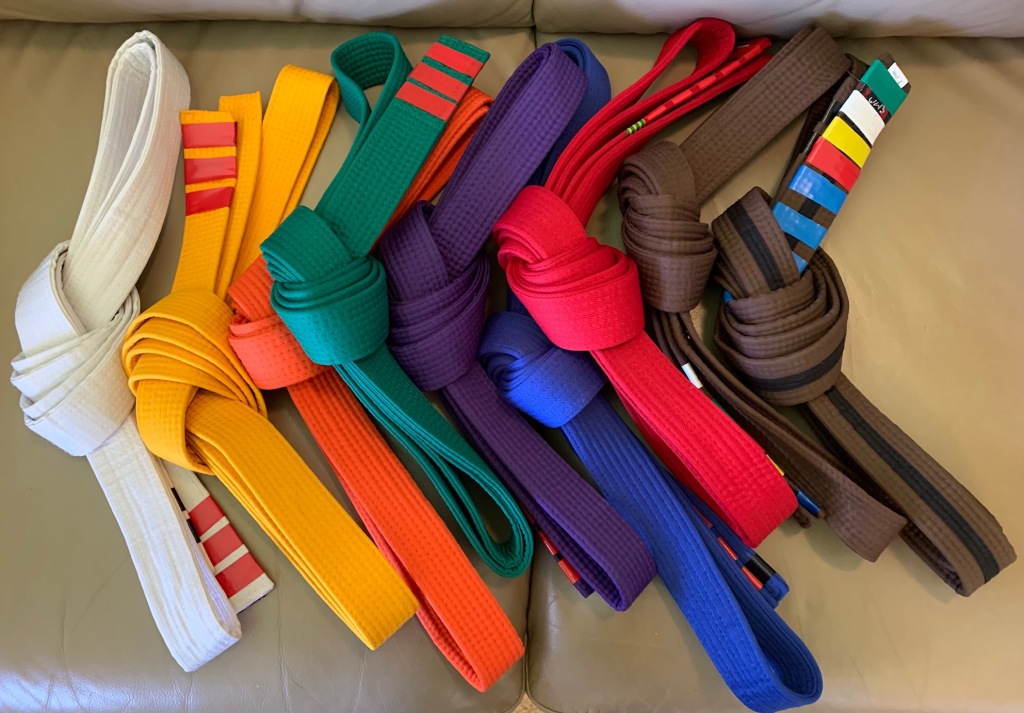
Poomsae
The following description of poomsae is adapted from material prepared by one of KMAA’s Master Instructors:
- Poomsae is a living record of techniques, forms and patterns commenced long ago when martial arts were banned or could not be written down (or those practicing could not read and write).
- Many moves, if done with good technique and full power, would be too dangerous to practice in sparring against a friend. Done slowly and repetitively, poomsae patterns are learned by the mind and the body through muscle memory.
- Learning and repeating moves in a training environment, and visualising an imaginary opponent, helps students to learn potential combat moves that will be delivered in a reflex-like manner.
- Poomsae is excellent for physical conditioning, enhancing balance, muscle control and endurance. Poomsae also develops coordination through undertaking moves using multiple body parts simultaneously, while also building dynamic flexibility and enhancing breathing control.
- Poomsae delivers huge mental and character-building benefits including developing perseverance, determination, a sense of continual improvement, focus, attention, intention, mindfulness, and self-discipline.
- In poomsae training, unlike some other more combative aspects of taekwondo, a student competes only against themselves.
- A pattern must be learnt for each belt level, with each new pattern introducing more complexity and additional techniques.
It is poomsae where the cognitive challenge comes into play for PLWP. In my situation, I now use a small amount of cognitive ability to do basic things like walk. Adding in a complex set of full body movements adds to those cognitive demands, with some training sessions leaving me physically and mentally exhausted. However, it is a brilliant thing to do for neuroplasticity (which is the ability of the nervous system to change its activity in response to stimuli by reorganising its structure, functions, or connections).
Competition
While on the topic of poomsae, I was given the opportunity to compete in the Australian Sports and Martial Arts Association 2018 Spring Open, in Sydney. Fully supported by my Senior Chief Instructor (James, known as Sir to students), I entered in the competition. As a red belt, I performed patterns five and six (Oh Jang and Yook Jang). I figured that I should try the competitive environment at least once, for the experience, despite being very far from my comfort zone! It was brilliant, although a little nerve-rattling, and I did reasonably well.
Below is a photo of the crew that ventured to Sydney, and a photo of the trio of winners!

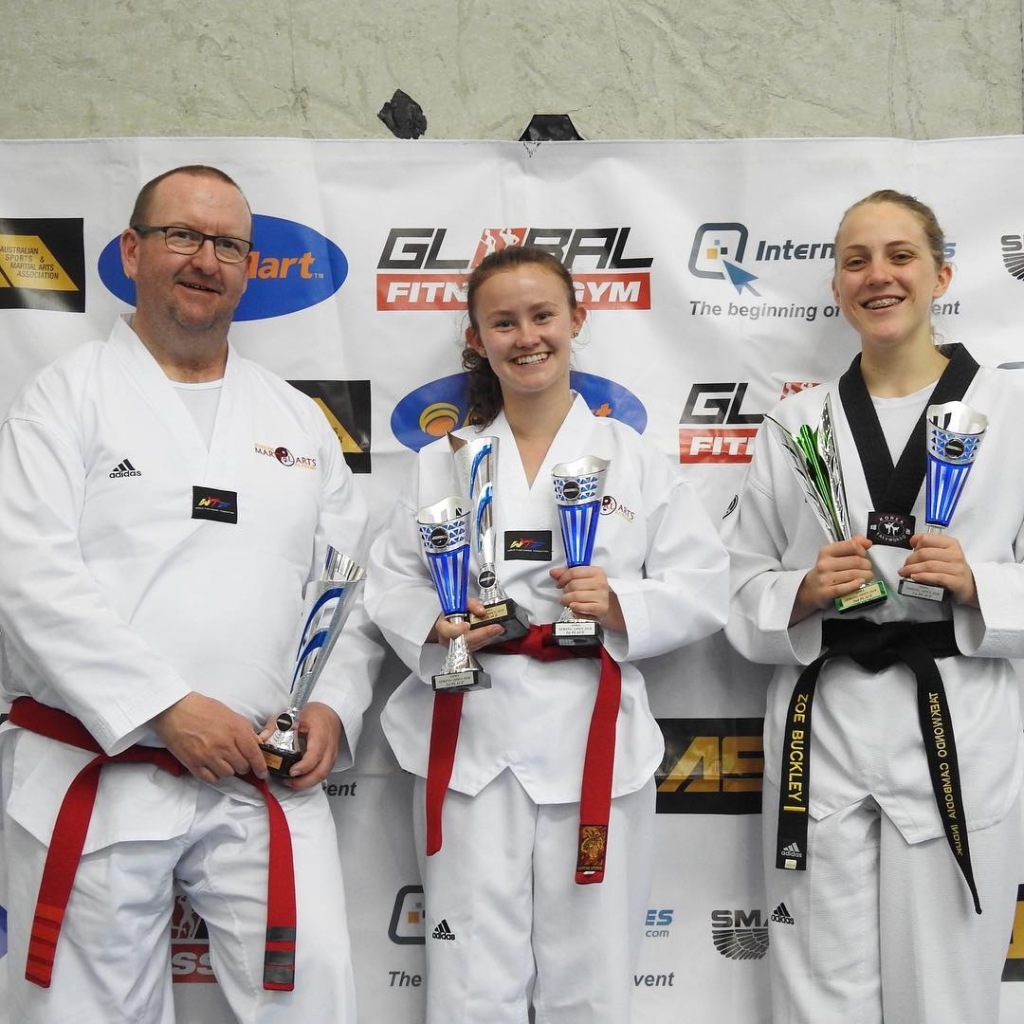
I thoroughly enjoyed the day! I had a great time watching my fellow students compete, particularly supporting Chris and Choi in their sparring bouts. I also greatly valued the travel time with Sir, discussing various taekwondo things and being able to pick his brain. On the way home we bumped into the Governor-General and his wife (General Sir Peter John Cosgrove, AK, CVO, MC, and Lady Lynne Cosgrove) getting coffee at a highway service centre. I was pleased that Lady Cosgrove remembered me from a function the previous year! In what other country in the world would the head of state drive themselves three hours for a royal engagement, and grab a coffee at a highway Macca’s on the way??? Nowhere but Australia!

Weapons
I participate with great enthusiasm in the weapons extension program. Weapons training adds an additional skill set, uses more of the upper body, and incorporates another full set of complex patterns. It is also a huge amount of fun!
The art of stick fighting was developed about 40 years ago by Yong Dai Cho, our ninth dan Grandmaster (and long-time President of Australian taekwondo peak bodies). He stated that stick fighting was an original taekwondo method that had slowly declined in modern practice. Cho therefore developed a philosophy and curriculum that reincorporates the art of stick fighting, known as Taekwondo Bongsul, into modern taekwondo practice. Taekwondo Bongsul can be used by traditional taekwondo practitioners and non-practitioners alike.
As with poomsae or belt patterns, each bongsul pattern becomes increasingly more complex, introducing new techniques and movements. There are nine grading levels in the weapons curriculum. Those nine levels can be attempted with three different weapons, the bong (bo staff or long staff), the kum (sword) and ssangbong (short sticks). A student must successfully grade for bongsul before attempting kumsul, and then ssangbongsul. In practical self defence terms, you can compare the three weapons to a broomstick, a shortened broomstick, and a broomstick broken in half.
Each level comprises a pattern component, and attack and defend components. The attack and defend sequences use moves from the pattern with each part to be performed stand alone, before facing a partner and executing both sequences in turn. The focus is on correct technique, concentration, balance, power, speed and accuracy.
Pattern 1 has 20 moves, with 10 moves in attack and 10 in defend. Pattern 9 is 100 moves, with 50 attack and 50 defend. Now, that is cognitively challenging for any person! Patterns are designed to be performed one after the other, as are the attack and defend sequences. Occasionally at a grading, Grandmaster Cho will ask a student to complete all moves from all levels up to and including the level being graded for! With levels 1-9 combined, it is a grand total of 760 moves. I watched a master instructor successfully complete levels 1 to 5 in an impressive yet exhausting display!
Below are some links to short videos of level 1:
- Pattern number 1 (Hyung 1), students using bongsul
- Attack and defend 1 (Daeta Jyon 1), students using bongsul
- Attack and defend 1 (Daeta Jyon 1), an extra clip with Grandmaster Cho using sanggbongsul, student using kumsul
I have successfully graded for bongsul level 6, kumsul level 4, and ssangbongsul level 4. I am currently training for bongsul level 7:
- Pattern number 7 (Hyung 7), student using bongsul
- Attack and defend 7 (Daeta Jyon 7), students using bongsul
The photo below, taken in 2018, is of me, my son Elliott, and Grandmaster Cho. He comes up from Melbourne twice a year for a day of weapons gradings. It was extraordinary spending time with this man, learning bits and pieces from him, and receiving his approval on our grading. On this day, I successfully graded level 4 bongsul, level 3 kumsul and level 2 ssangbongsul, while Elliott successfully graded level 3 for all weapons.
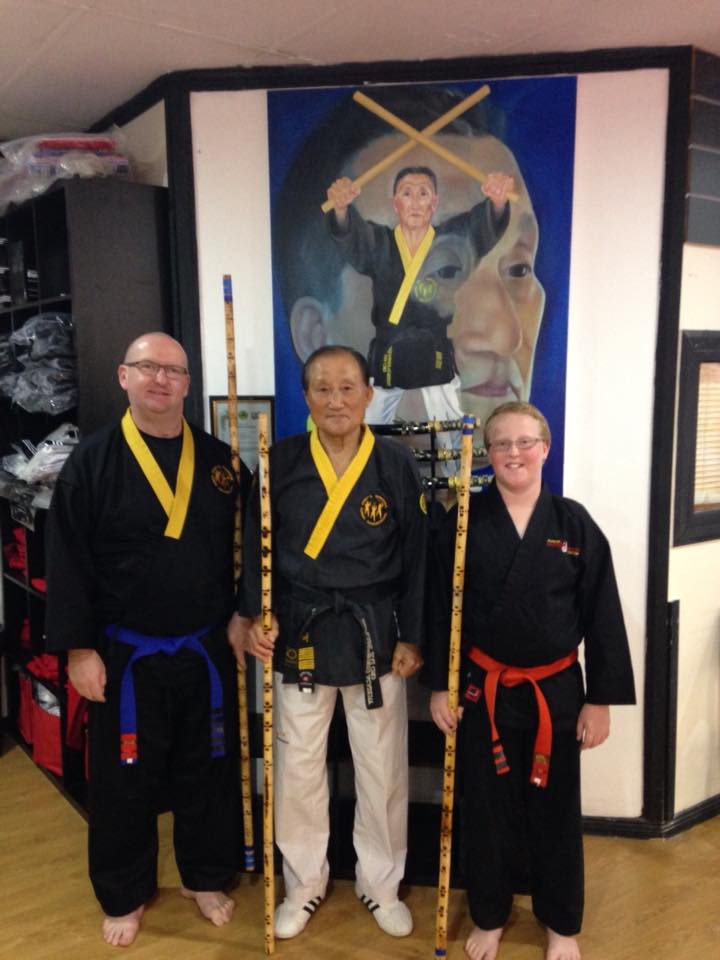
Black belt grading
The belt exam process is extraordinary! The outcomes of the process were described by one of KMAA’s Master Instructors:
Belt exams build resilience, create a sense of achievement and pride, teach students to deal productively with pressure, and deepen the bond with peers who go through the exam together as a team.
Ms Rachel, Master Instructor 5th Dan
Although I have felt nervous at a grading before, I’ve always known that I have reached that point after multiple level tests and been deemed ready to grade by my instructors.
The black belt grading was exhausting but exhilarating! The time went quickly!! Techniques, poomsae, sparring and board breaking, all smashed out (literally!) in an hour. A short video of my board breaking is below; the three breaks are axe kick, side kick, hammer fist.
The photo below shows the end result, a monogrammed black belt with the first dan bar, and the certificate of accomplishment. And a tired grin. I will never forget the incredible cheering and applause as my name was announced and I went up to receive my belt.
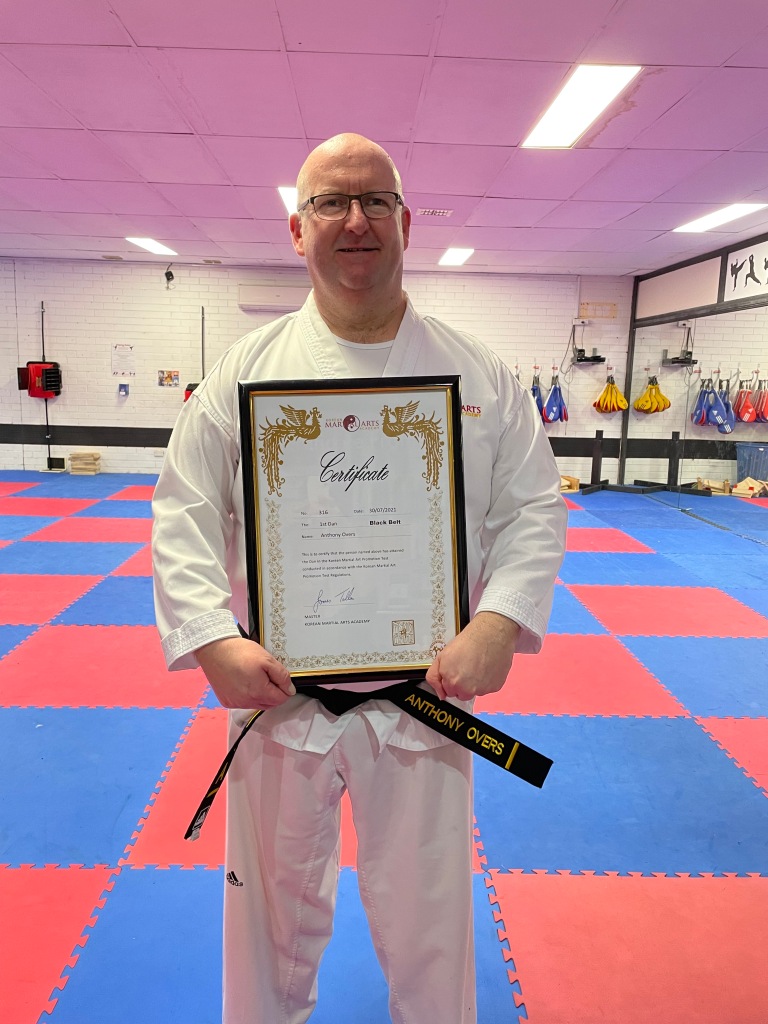
Quick photo after the grading with my friend James; he is my Senior Chief Instructor (7th dan), the owner of KMAA, and has been my biggest supporter and ally throughout my training.

My instructors were right about bonding with people you train and grade with. The photo below is of me with the two people I am closest to; Jayne graded with me for four belts (but advanced a little quicker thereafter), and Natalia graded with me for the last three belts (and Jayne was in the black belt grading with us, going for her second dan). The photo was taken at our first training session after the grading.
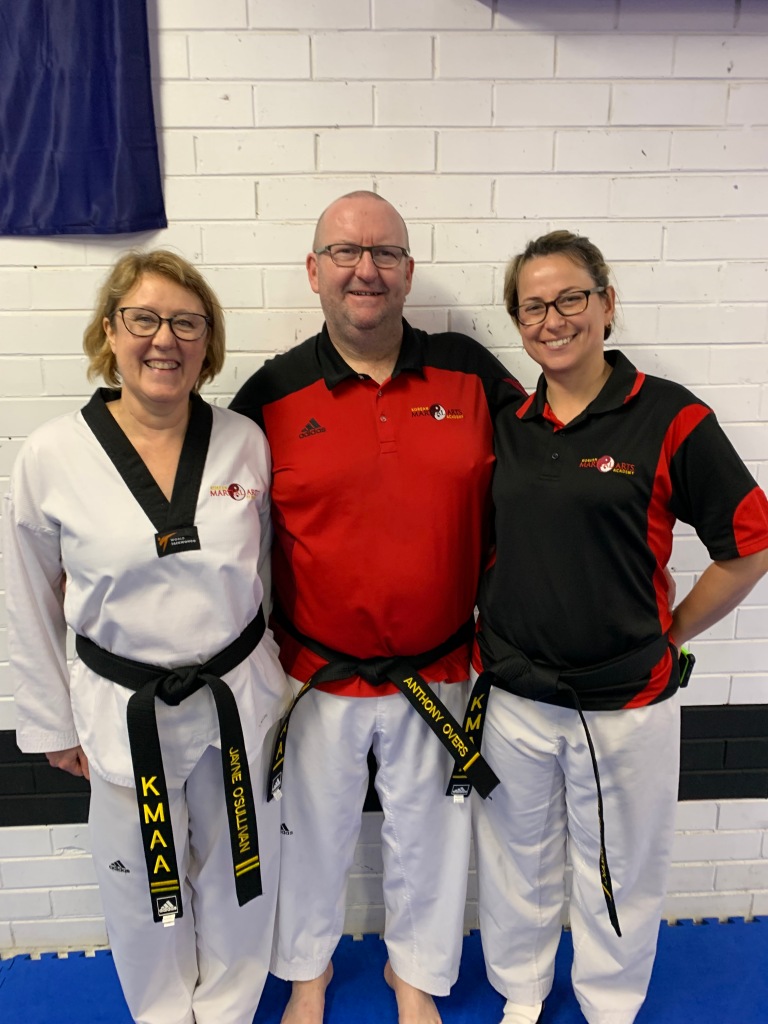
Just quickly, while on friendships, the photo below is of me with my great friends Tim and James. I have completed a substantial amount of weapons training and several gradings with Tim, he’s a great human.

Inspiration
A handful of people have told me in the recent past that what I’m doing at training is inspiring. A couple of my master instructors have said that I am an inspiration to them and others. Now, that is all very flattering, but honestly I feel a bit taken aback by it. I never set out to do this for anyone but myself. However, I do recognise that what I have achieved is significant, and if I am indeed considered an inspiration to others, then so be it, that’s great. I would be very pleased if other PLWP started martial arts because they have heard that others have!
Impact
There is no doubt in my mind that the physical activity I get through each week has delayed the progression of my disease. Taekwondo two or three times a week, strength training twice a week, and a weekly stretch therapy session adds up to a significant training regime. I would undoubtedly be in a far worse state now had I just sat on my butt and done nothing.
As I mentioned in the earlier in this post, the degree to which exercise impacts of affects the delay of disease progression has been difficult to ascertain.
The graph below, taken from this paper, makes an attempt at visualising the effects of exercise therapy. The Y axis on the graph represents the amount of dopamine producing cells in the brain, i.e. by the time of diagnosis, 70 percent of those cells are gone. You can see the question marks labelling what are essentially best guess lines representing the impact of exercise in delaying further loss of cells.

The paper states that exercise may not only reduce the risk of developing Parkinson’s in vulnerable populations but also benefit PLWP by potentially protecting the residual dopamine neurons. The paper concludes that future research needs to establish standardised exercise protocols that will maximise exercise-induced neuroprotection and neurorestoration in Parkinson’s patients.
To state the obvious, exercise is a universally available, side effect-free medicine that should be prescribed to vulnerable populations as a preventive measure and to PLWP patients as a component of treatment. Simple!
Do you have Parkinson’s? Get active!
Looking for a physical activity? Give martial arts a try!!
Thank you
I could not have reached this point without my fantastic, dedicated instructors. My heartfelt thanks to my friend and Senior Chief Instructor, James Tallon. A huge thank you goes to Christine, my weapons master instructor, for her unending encouragement and support. Thanks also to the following instructors and senior black belts that have helped along the way: Tim, Kay, Rachel, Steven, Mark, Deidre, Scott, Lena, Penny, Kristina, Steph, Shane.
And of course, a massive thank you to my family for their support. My son commenced taekwondo training soon after I did. He has since taken a break, having reached his blue belt, and graded to level 6 with all three weapons. It was indeed a lot of fun to train with him during weapons classes for a couple of years (I hope he returns to it!).
If you have made it this far, thanks so much for reading!
Anthony Overs
Canberra, Australia
Thanks for this Anthony, it’s been well worth the time it took to read. As I’d expect, it’s thoroughly thought-through, well planned and executed, and extremely honest. I learnt a lot from it (about you, about Parkinsons and even about taekwondo). You sound surprised that people have found you inspiring because (unsurprisingly!) you’d never considered that. For a start I think that anyone who finds themselves inspiring probably isn’t going to do it for others! People who inspire me at least, do it just by being themselves. I don’t recall my dad ever telling me how to behave, but just by going about his life he showed what a decent, honest, quiet and moral bloke looks like. (How much I’ve been able to emulate him is another issue of course.) When I think of people who I consider mentors in environmental work, they didn’t do so in any active way. I just saw how they went about it and tried to learn from it. They never knew. And as I get older I take inspiration from people a decade or so older than me who show me that I can still be active, alert and even achieve things when I’m ‘old’; I need that. Some are famous (Sir David A being a key one of course) some are just people I know.
And you inspire me by showing me that in the face of a challenge that I can’t begin to imagine in my own life, I could – I hope! – still be gracious, good humoured, quietly courageous and determined to make the most of the lousy cards life’s dealt.
Oh, and congratulations on the black belt – a truly impressive achievement, for which you should be proud in your own quiet way.
LikeLiked by 1 person
Thank you, Ian, for your thoughtful and considered response. It is a long piece but I’m pleased it read well. Not even for one second did I consider that anyone would consider me inspiring. I’m simply trying to delay progression. Preparing this post I guess is in response to the inspiration comments, in the hope that anyone in similar circumstances might try what I did, and similarly embrace the multitude of benefits.
LikeLike
Anthony! That is outstanding. Achieving your black belt is such a rewarding accomplishment – Congratulations!!! Fantastic post. Justine (daughter of Steve (and John)) from Jays Camp 🙂
LikeLike
Thanks so much Justine!!
Great to hear from you and say hi to the old boys!
LikeLike
Amazing achievement Anthony.
LikeLike